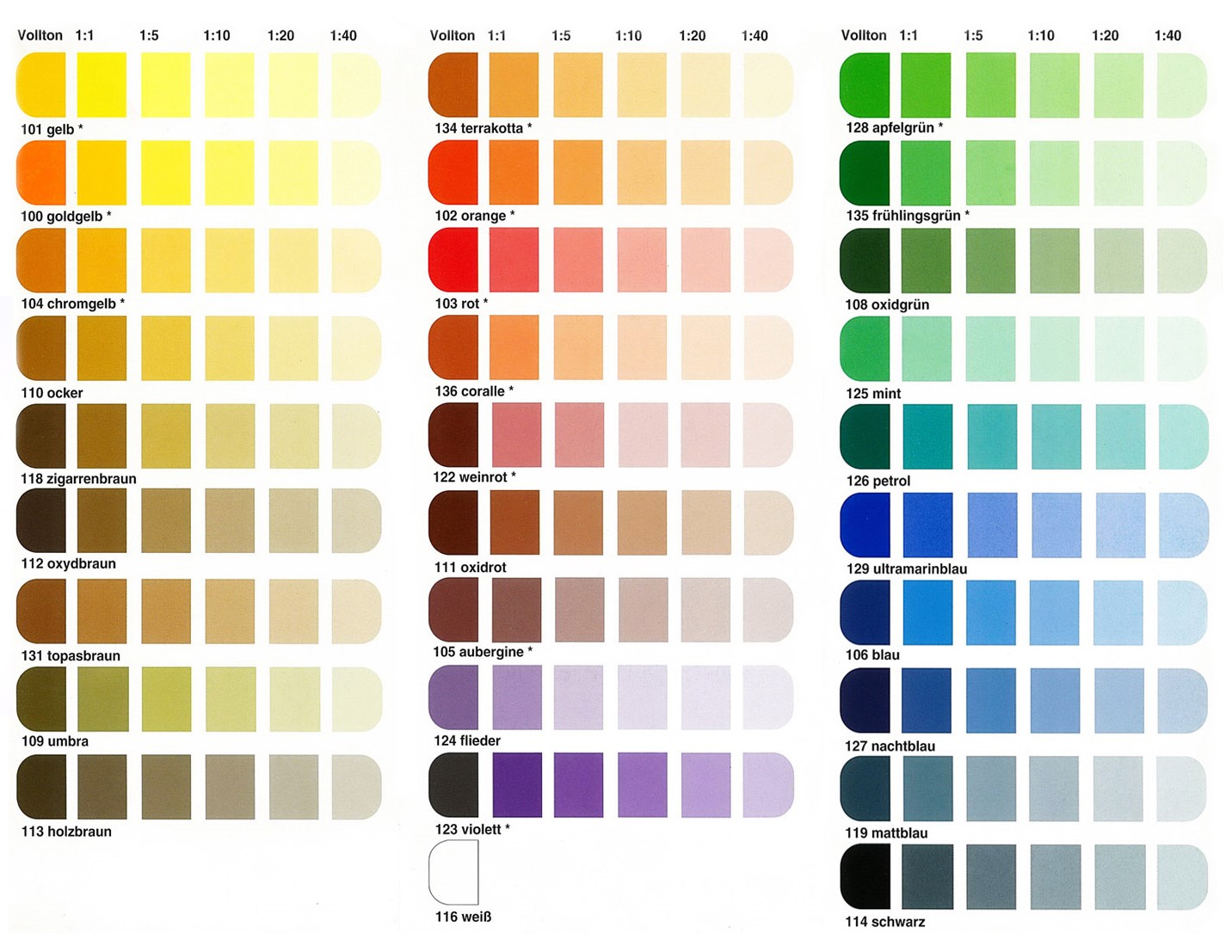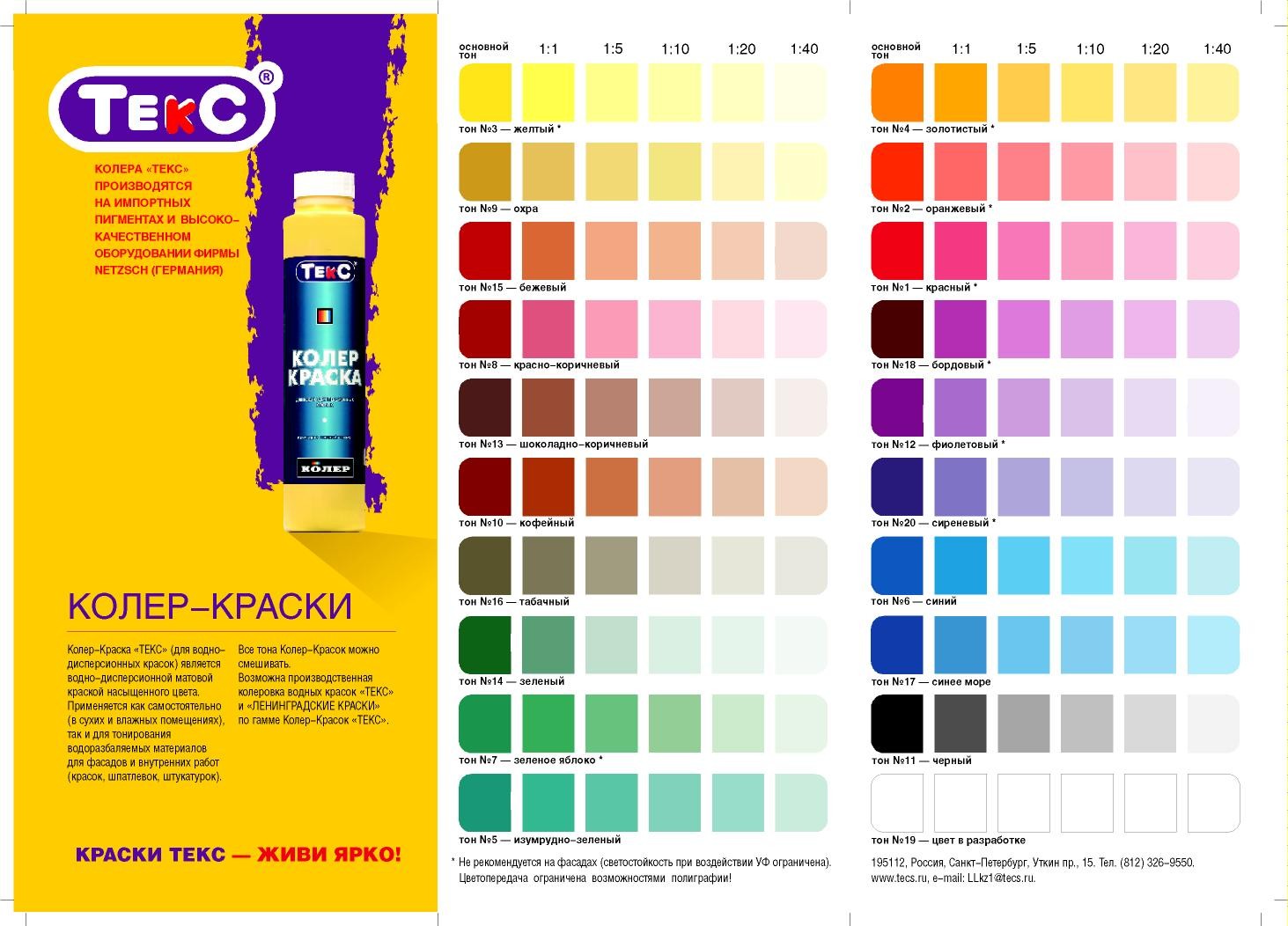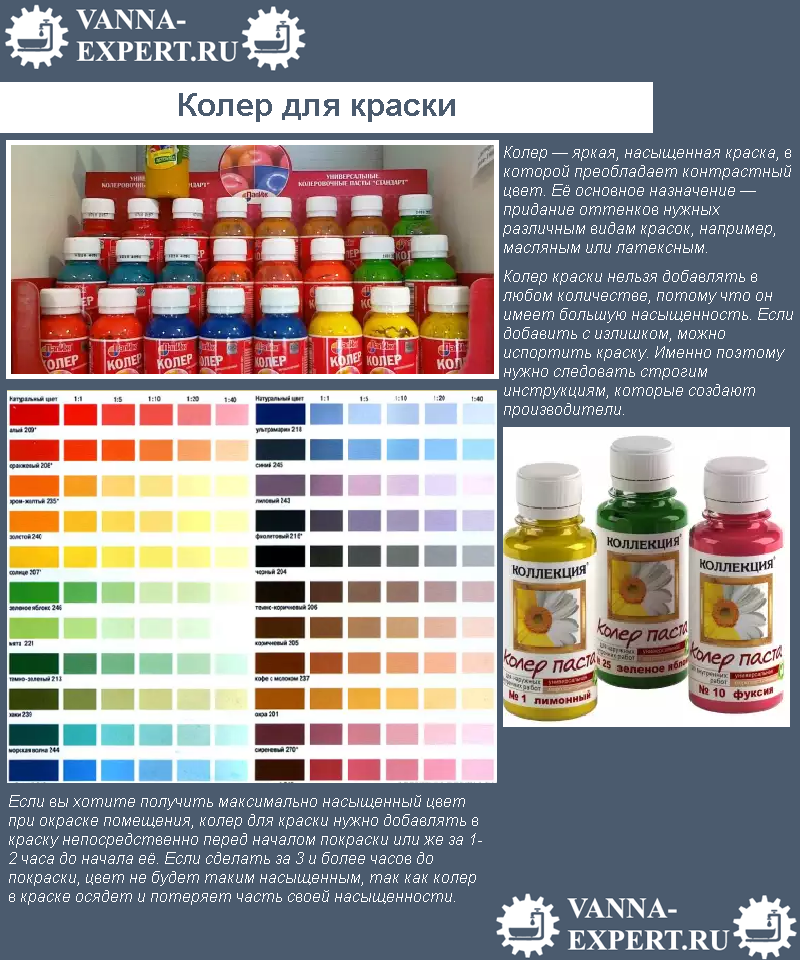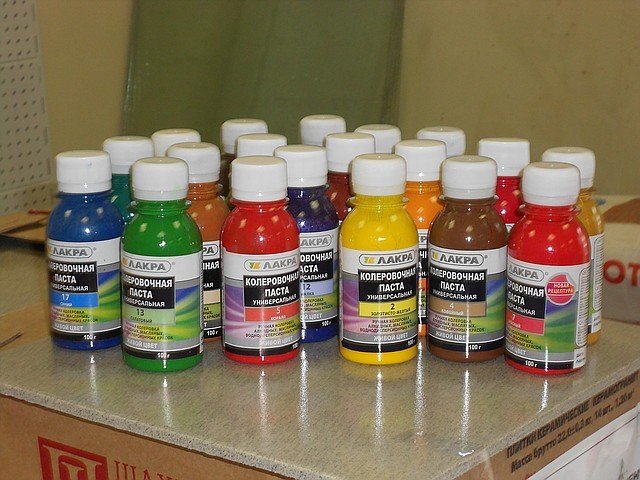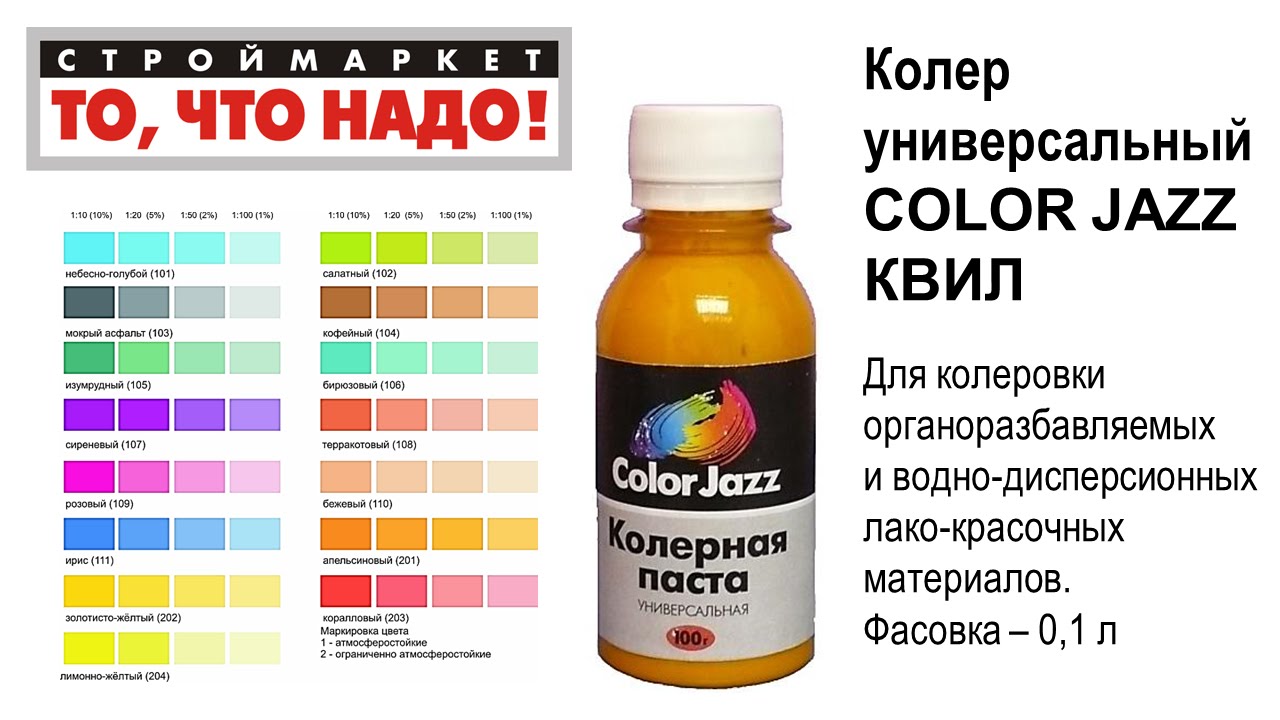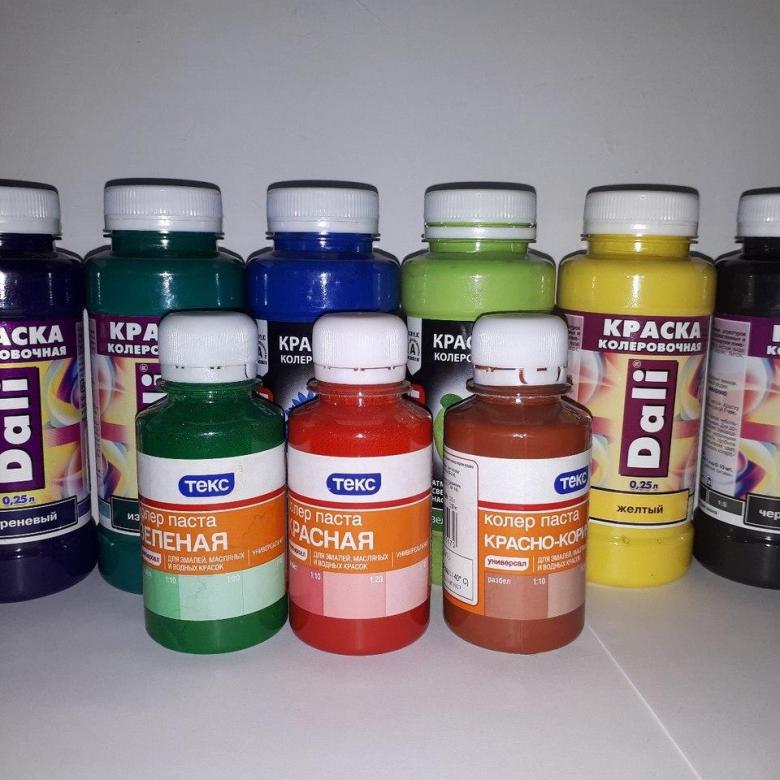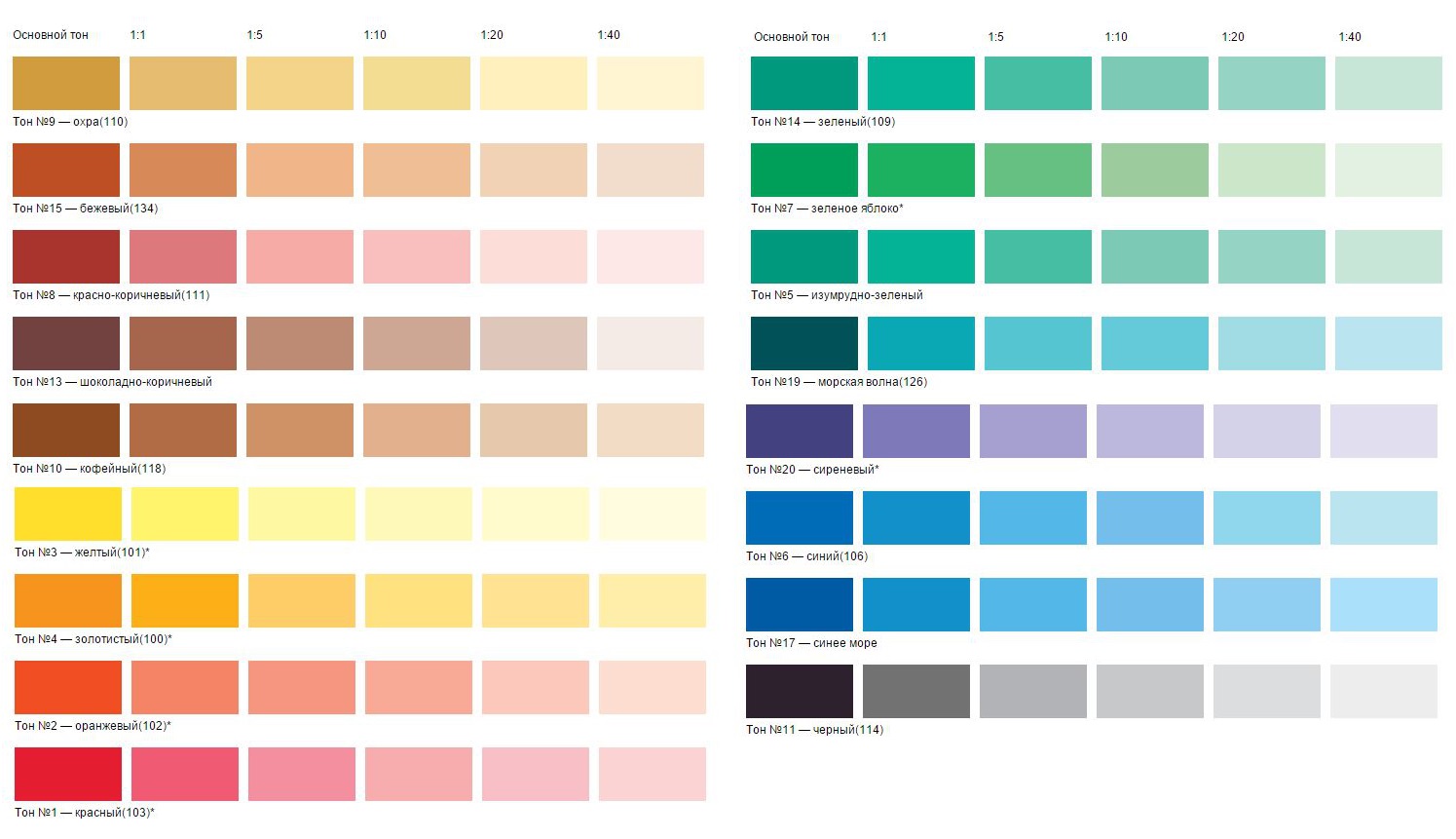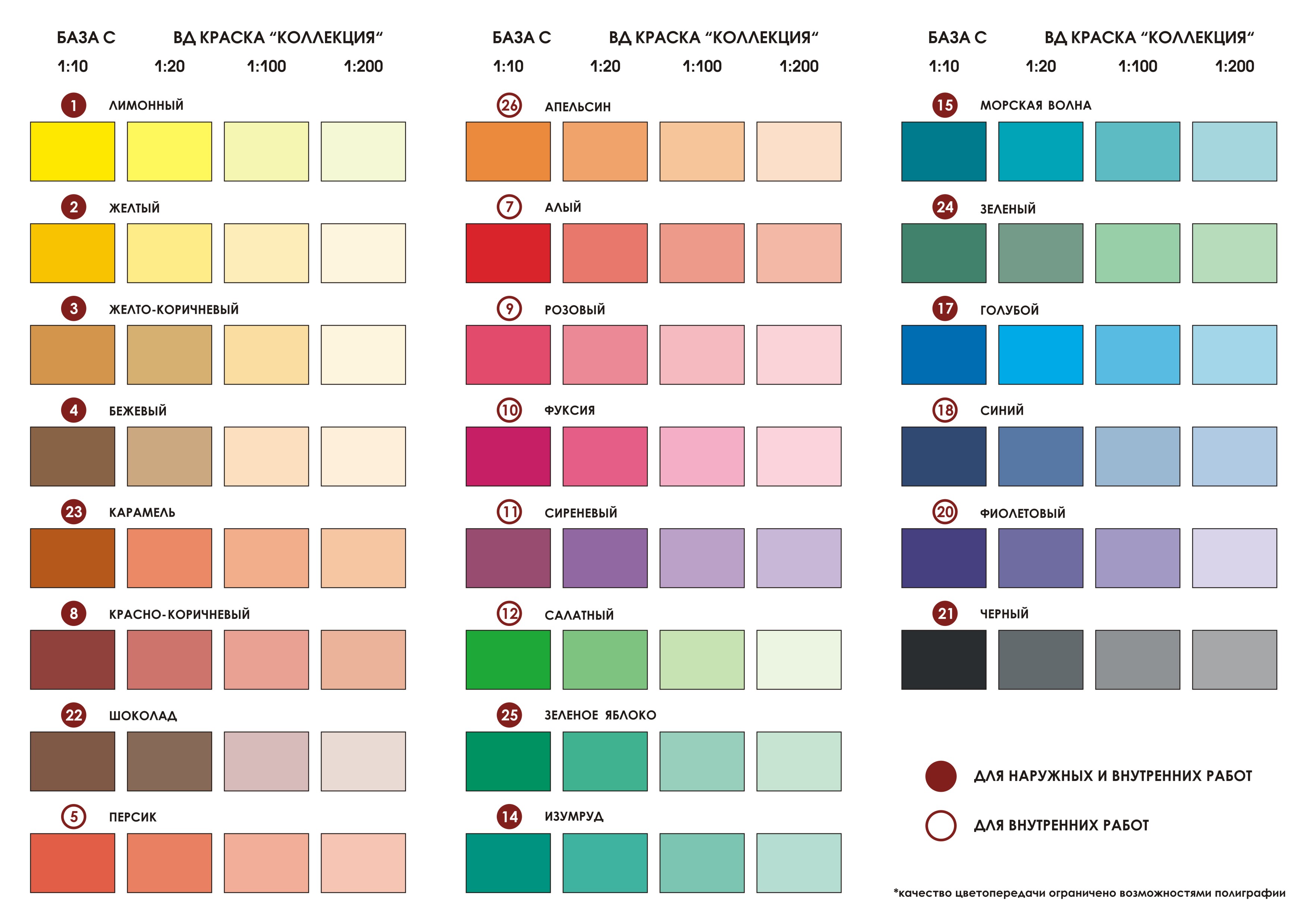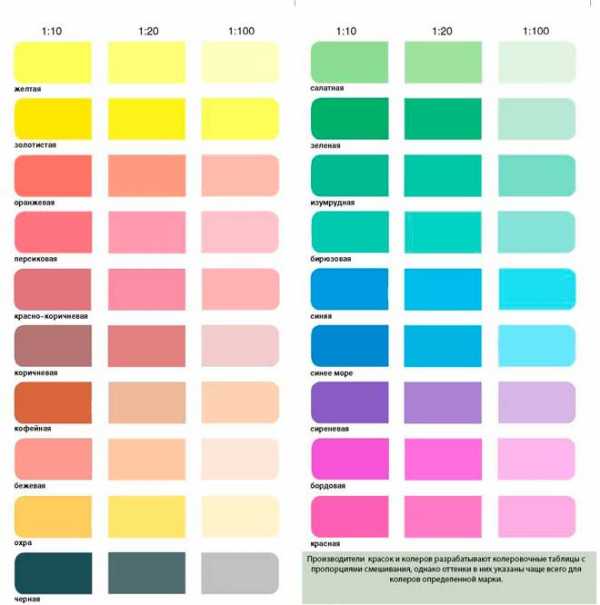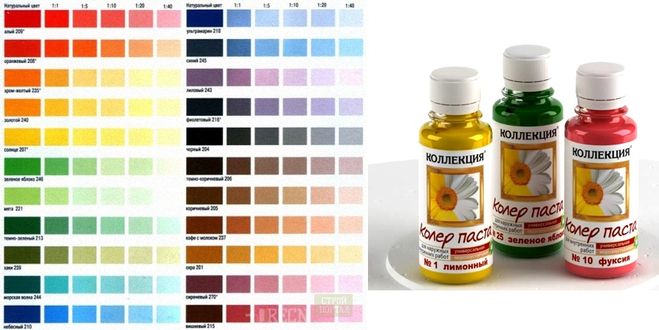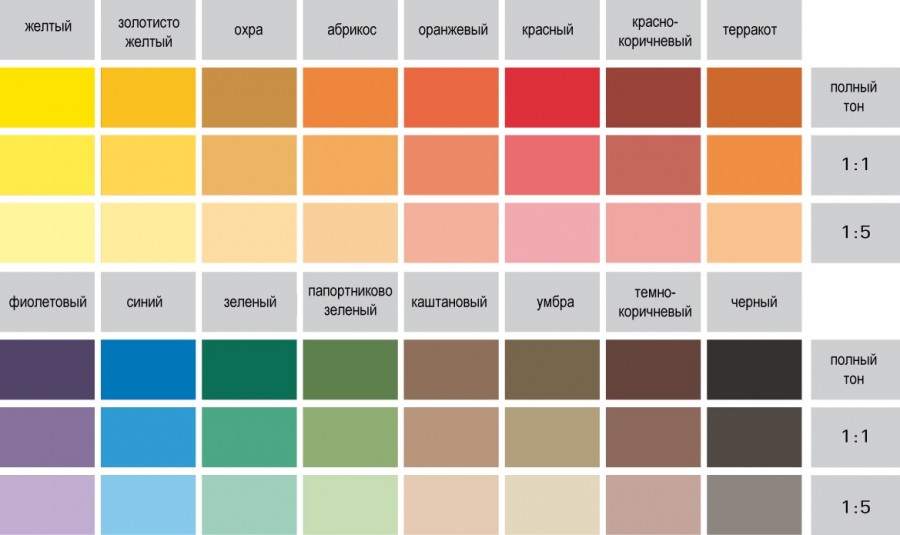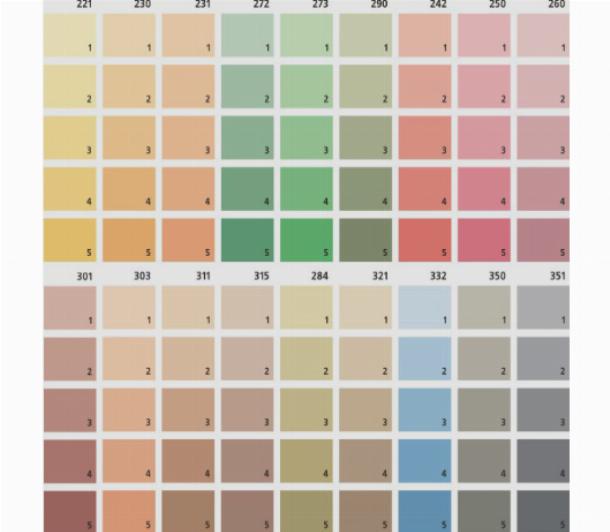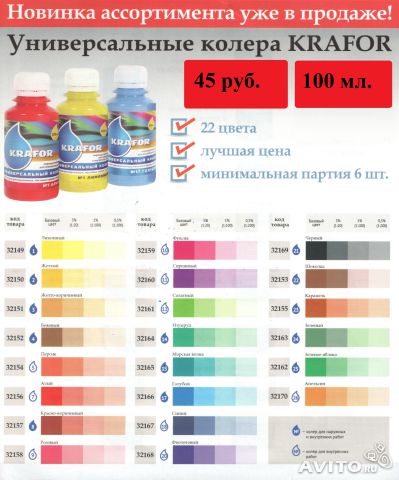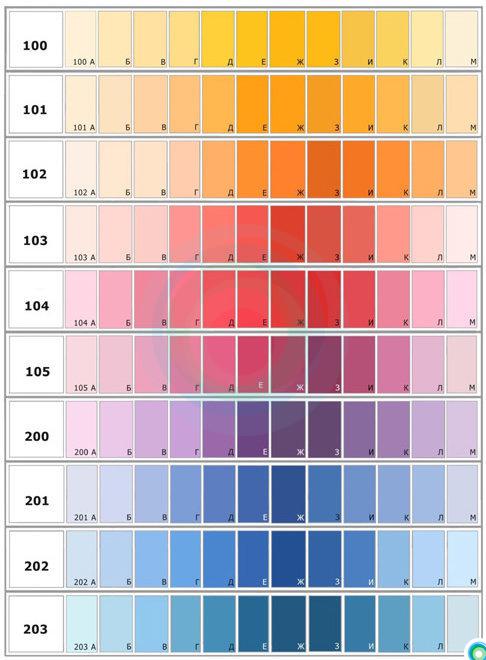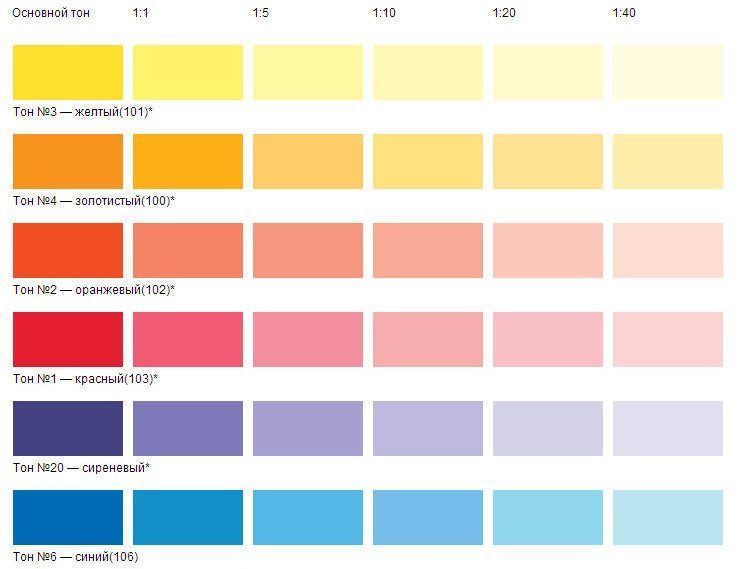Varieties of color
Before you go shopping for a color scheme, pay attention to the existing types of this tool. The coloring matter is distinguished by the composition of its components, by the form of release and by the area of application.
According to the composition, several types of color are distinguished:
With organic pigments. This type of color scheme has a richer and wider range of colors. Due to its origin, organic paint fades quickly when exposed to sunlight and is therefore not recommended for facades.
With inorganic pigments. The choice of colors of this color scheme is much poorer, but this pigment is resistant to destructive factors, including sunlight.
According to the form of release, it happens:
- Color in the form of paint.
- Kohler in the form of a dry powder.
- Kohler in the form of a paste.
According to the area of application, they classify:
- Universal color is a substance that can be mixed with any paint.
- Highly specialized color - this pigment is produced differently for each type of paint.
How to choose?
Consider how best to choose the right color scheme, what you need to focus on. Selection criteria based on characteristics:
- Manufacturer. Despite the prejudices, a domestic manufacturer can offer a product that does not differ in quality from a foreign one. And its price will be much lower. If the base paint has already been purchased, then it is advisable to take the color scheme of the same company.
- Tara. It is more convenient to use packaging with a narrow neck, so it is much easier to pour the required volume.
- Base paint type. The most popular option is for water-based emulsion. This does not mean that there are no options for other bases. But finding them in the market won't be easy.
- Availability of a shade map. Almost every manufacturer has such brochures; it is much easier to choose the desired shade for them. It is better to check with the seller when buying the availability of such a card.
- Tint. Depending on the lighting, the ready-made shade may look different in different rooms. The recommendation is not to mix the entire volume of the base at once, give time to "get used" to the shade and possible adjustments.
- Pigment type. They are organic and synthetic. For a well-lit room, it is better to choose a product with a synthetic pigment, as it is less susceptible to fading in the sun. Under artificial lighting, organic pigment looks better: it is more saturated, has natural, "pure" colors.
Computer operation
There is a color matching by means of a special computer program. In this case, you can use tinting machines (most often varnishes and enamels are used) or a special catalog of the pigment liquid manufacturer.
Computerized color tinting has become widespread due to a number of advantages:
- obtaining the desired color in the shortest possible period of time;
- the desired shades can be recreated if you save the desired tone in the computer;
- there is a huge palette of colors and shades.
The main disadvantage in carrying out such work is the impossibility of creating the desired color at the place of work.
What to consider
Painting a wall with a color scheme is carried out using a special device that can be bought at a special hardware store. Tinting with acrylic paint must comply with certain requirements:
- color paint is created directly inside the room, which will be painted. This is mandatory for evaluating the resulting tone in both artificial and daylight;
- color shades for water-based paint should be added in small parts or drop by drop so that the dye does not damage the main tones;
- it should also be borne in mind that the paint on a large area looks a little different than on a small section of the wall.
It is rather difficult to obtain a black color scheme, since even one drop of it can completely change the color, and it will be much more difficult to lighten it. Very often a dull gray color is obtained. That is why you should stock up on small cans and do everything neatly and consistently, applying the product drop by drop.
It is also important to remember that on the wall using water-based paints, the resulting color will look much brighter than in the container.
To obtain a good mixing result, choose a white paint of the desired base and without admixture of yellowness. Color for acrylic paint will give the desired color only when using a snow-white base. If you plan to paint the walls, then the colors of the color scheme should be matched specifically for them, and not for the ceiling, which plays an important role. These types of formulations for acrylic paints have some differences in terms of wear resistance, elasticity and soiling.
If it is required to re-tint the water-based paint, then it is very important to purchase the compositions from the same manufacturer, since the same tone for different brands can be very different. When buying latex paint, you need to remember that it has a rather thick consistency, therefore it requires high-quality and long-term mixing
The solvent in this case will be water, which is carefully poured in until the desired mixture is formed. After adding water, the main dyes are carefully added dropwise to the composition.
When buying latex paint, you need to remember that it has a rather thick consistency, therefore it requires high-quality and long-term mixing. The solvent in this case will be water, which is carefully poured in until the desired mixture is formed. After adding water, basic dyes are carefully added dropwise to the composition.
"Recipes" of the most popular shades
Now in the interiors of modern dwellings, you can find the most different and most daring shades. It happens sometimes - you look at the color and think, how did you get it? Here is an example of the most noble shades and their composition in percentage:
- Royal Red - Add 5-10% cold blue to the cool red base. You can experiment with the same content, but warm colors;
- Tomato Red - Easy to get by adding 5% yellow and 5% brown to the base red;
- Raspberry - its base is blue, to which 1-2% of white, brown and red are added. If the intensity is not enough, add again a small amount of auxiliary colors in equal shares;
- Olive - 10-20% yellow is dissolved in the green base, depending on the desired saturation;
- Turquoise green - add no more than 20% blue to the base of the standard green color;
- Bottle green - obtained by mixing yellow and 20-40% blue;
- Turquoise blue - easy to get by adding 10-15% green to standard blue;
- Royal Blue - This chic shade is obtained by adding 10-15% black and 2% green to a blue base;
- Deep dark blue - obtained by adding 5% black and 2% green to blue;
- Golden Brown - For a radiant effect, add 10% blue, 10% white, 10% red to the yellow. Moreover, the higher the percentage of the yellow base, the higher the contrast;
- Mustard - add 5% black, 5% red, 1-2% green to the yellow base;
- Noble pink-gray color - when added to white, up to 5% black and up to 5% red;
- Blue-gray tint - obtained by adding 5% light gray and 1% blue to the white base. With the same proportions, but with the addition of green instead of blue, they will give a gray-green tint;
- Lemon Yellow - A bright and positive color is obtained by adding 5% white and 1-2% green to standard yellow. Moreover, if the base yellow is a warm shade, then the final color will give more to yellowness;
- Aqua color - can be obtained by adding 35%, no more, green and 5% black to white paint;
- Royal magenta - obtained by adding small amounts and in equal proportions of black and blue to a red base until the desired level of saturation is obtained;
- Burgundy - add 5 to 10% of each color to the red base, but in equal parts - yellow + brown + black;
- Plum - A wonderful shade is obtained by adding 10% black, 10% blue and 5% white to the red base.
All of the above is a prime example of the glazing process. After that, the resulting shade can be used either as an independent composition, or as a color scheme, which is usually diluted in a white base.
Surface preparation
Before painting, it is important to clean the wall of dirt, traces of previous coating, mold, etc. If the surface is uneven, it is better to plaster and sand it
It is also important that the wall covering for painting is also white, because the dark background will be visible even after several layers of paint.
If the surface is uneven, it is better to plaster and sand it
It is also important that the wall covering for painting is also white, because a dark background will be visible even after several layers of paint.
For better adhesion (adhesion) of the dye to the surface, it is recommended to use a primer suitable for this type of paint.
Advice. You should carefully read the instructions, recommendations for use and the proportions of the components indicated on the package.
This will avoid unpleasant surprises in the process. tinting paints for walls and painting and get the desired shade without much difficulty.
A video instruction will explain in detail how to make paint tinting without errors.
There are several, the most popular methods of finishing wall surfaces (wallpapering, ceramic tiles, painting), each of which has a lot of advantages and disadvantages. As for painting, today it is the easiest and most inexpensive way to transform a room and make all your design dreams come true.
Most paints have excellent physical, technical and operational characteristics, and the tinting of the paint will help you choose the right shade
When planning to apply paint in the interior of your home, you need to pay special attention to the color scheme, since the color of the walls should be harmoniously combined with all decor elements and furniture.
If the desired shade of paint cannot be purchased in a store, you can tint the paint yourself at home.
Tinting paints at home is a responsible and difficult task, but sometimes this is the only way to get the desired shade. For example, if a person needs yellow, he can easily buy it in a store, but if the color of orange juice suits the interior (this complex color consists of yellow and orange), then it is better to tint the paint yourself in this color.
Tinting is also necessary if you need to paint a room in several colors, since only with this method it will be possible to obtain shades that most closely match each other.
Mixing paints will help to get the desired color, but here you need to know exactly which groups of paints and varnishes can be mixed with each other (some types of paints are incompatible with each other).
And also you need to know exactly what kind of shade will turn out as a result of mixing the original paints.Recently, phosphoric paint and reflective paint have been used to create a unique interior. These paints can be applied to a variety of finishing materials.
In a store for a customer, they can create the desired shade in a tinting machine, but it often happens that in a store sample, the house starts to look completely different.
The fact is that the color is influenced by many factors (lighting, painting area, etc.). The advantage of home tinting is that the desired shade can be obtained immediately before painting and more accurately select the color.
There are only two most important tinting rules:
1) The desired shade must be selected with the lighting that will be in the room.
This means that you need to see how the created shade looks in different lighting conditions: in daylight, when the electric light is on.
That is, if a chandelier hangs in the room, then tint the paint and paint the walls with the light of this chandelier, and not with another light source.
2) Applied over a large area (especially on a vertical surface), the color will appear richer than on the sample.
In order for the room to turn out to be the color you need, you need to reduce the amount of color paste by 20%.
For example, if on a sample you created a complex color "cocoa with milk" by adding 5 ml of the "coffee" color and 2 ml of the "pink" color to 100 ml of paint, then in order to create the paint of the desired shade for the entire wall, you will need 1000 ml of paint add only 45 ml of "coffee" and 16 ml of "pink" (20% less).

What is paint color
The word "color" is translated from the Latin "color" as a color or tone. In the chemical industry, color is a special highly concentrated pigment composition, with which you can get almost any shade of paint. Moreover, not only water-based, but also facade, oil, acrylic products can act as a basis. Depending on the concentration of such a pigment composition in the paint, you can achieve both rich and bright colors, and muted, pastel shades.
What is it needed for
The use of color schemes helps property owners to translate almost any design ideas into reality. The process of mixing and diluting a paint and varnish material with a pigment is called tinting. Its use is suitable not only for finishing work inside the object, but also outside it. With the help of a special pigment solution, you can get unique shades, for example, you can give the paint a copper, pearlescent, bronze, golden hue.
Kohler can be used on concrete, brick, plastered walls. Compositions with its use can also be processed on other surfaces: plasterboard, wood, fiberboard, chipboard. The use of tinting is necessary in the following cases:
- the initial layer has small defects;
- you need to choose a shade in accordance with the color scheme of the interior;
- it is required to decorate the interior using several shades of one or more colors;
- you need to correct errors that have arisen when calculating the volume of paint or the absence of a color previously used.
Views
- With organic pigments. Products of this type are distinguished by a more saturated range of colors, but the paints and varnishes obtained on its basis lose their brightness and saturation over time due to exposure to sunlight. For this reason, formulations with organic pigments are not considered the best choice for facade paints.
- With inorganic pigments. Such products are more resistant to aggressive external factors, including burnout. True, such a color scheme for paint cannot boast of a wide range of shades.
Tinting rules
You can color the paint manually or by computer.Thanks to the first option, you can save a significant amount of money and perform the procedure directly at the repair site. There is also a drawback: it is almost impossible to reproduce exactly the same tone again. The second type of tinting is controlled by a special program. The operator only needs to choose the color of the color scheme, and the program itself will determine the proportions, after which it will give out the finished composition.
Having decided to dilute the pigment yourself, consider the technique:
- Decide on the required amount of color scheme. It is better to buy more initially than look for identical products later.
- It is recommended to select a color for painting surfaces with the manufacture of a probe. To do this, fill a small container with 100 mg of white paint and add a few drops of pigment to it. Get the desired shade by mixing.
- Check how the resulting composition looks on the wall or other surface to be painted. The color of the finished solution does not always match the shade of the paint and varnish applied to the wall. The result should be considered under the prevailing lighting in the room (artificial or natural), after the composition has dried.
- If you know how many drops you had to add to get the desired color, then by recalculating the consumption of the composition per liter of paint, you can dilute and get the required amount of color.
- You need to add the pigment composition to the paint and varnish material in a thin stream. At the same time, do not forget to mix everything thoroughly to get a concentrated composition with a uniform color.
Tinting technology
Before tinting the paint, you need to calculate the color consumption, choose the tone and prepare the necessary tools. Of course, if you do it at home. To facilitate the work, specialists have created a special tinting table, thanks to which you will know how to properly dilute the pigment, in what ratio. But you need to understand that it is rather arbitrary, and the proportion may differ depending on the paints and components used.
Color calculation rules
To correctly calculate the ratio, it is necessary to subtract a fifth of the pigment quantity. As an example, consider the color that is as close as possible to the sea wave. To obtain such a shade, you need to add blue and green colors to the white paint. For example, 200 ml of paint consumes 10 drops of blue pigment and only 4 drops of green. To calculate the consumption per 5 kg of paint, you accordingly increase the amount of pigment by multiplying. As a result, we get: 250 drops of blue and 100 drops of green.
Mixing components - step by step instructions
- Prepare some small containers. Remember, they must be perfectly clean.
- Pour in the tinted ingredients and be sure to record the data on the amount of ingredients.
- Apply a small amount of the resulting paint to the surface to be painted later.
- Let dry.
- Apply another coat if necessary.
- Color assessment is carried out only in daylight and after complete drying.
- After you achieve the desired shade, you can start tinting the entire mass of paint.
- For a large area of staining, you will need many containers or one, but large. If you use 3-4 small containers, then pour the paint into it in exactly the same amount.
- Wash containers, dry thoroughly and dry. Even dust must not be allowed.
- Stir the laid out paint with a wooden stick and start gradually adding color. Stir with a piece of wood first, then use an electric drill with a mixer attachment. This will give uniformity.
- Then you can paint the surface.
Overview of the most popular colors
Today, the construction market is simply overflowing with various coloring pigments of any type and manufacturer.The most popular and demanded among foreign and domestic pigments are the following:
- Tikkurila Symphony is used for tinting Tikkurila paint. Possesses the widest range of shades (2256), up to 10 only whites. It is used for interior decoration works. But for the interior, the company of the same name produces the pigment "Tikkurila Facade". There are also options for adding color to antiseptics and varnishes.
- Natural Color System (NCS) is manufactured according to Swedish and Norwegian standards. In this system, there are 6 basic (base) colors and many shades. Thus, it turns out that the basic shades are qualified by letter designations, and the percentage of the main color in the color scheme is digital.
- "Tex" is produced specifically for water-dispersion dyes. It is of high quality, despite the fact that it is a domestic product. It is made from imported active pigments on German equipment.
- Aqua-Color is produced in St. Petersburg. Differs in versatility, high quality and a wide range of shades. It is used for all paints and finishing works.
- The Olka manufacturing company produces the Unicoler paint. Designed for many types of LCS.
- The Moscow factory "Rogneda" produces coloring pigments "Dali". Also of high quality, used for enamels, whitewash, water-based paints. Suitable for all surfaces.
Read about how to tint acrylic paint in a special material on our website.
Characteristics of PF 115 paint.
The appearance of this paint is matte or glossy. White is the primary color. In addition to the main color, enamel is also produced with other colors (gray, blue, yellow and cream are the most common options).
In general, this paint has a high-profile status - the best domestic development among alkyd paints and varnishes. One of the main technical advantages of enamel is the ability to maintain its quality in all climatic zones.
Enamel paint PF 115 is able to withstand any atmospheric influences, is friendly with strong winds, rain, and also easily tolerates sudden temperature changes from -50 to +60 degrees. Due to its structure, this paint forms an excellent waterproof layer. This allows you to wash the surface with paint with any detergent.
Where are they used?
Most often, colors are used when you need to choose a certain shade, taking into account the entire design of the room, as well as when decorating the interior, when you may need some special color of acrylic paint. But to get it, you just need to add the necessary pigment to the acrylic mixture.
Also, colors may be needed if the shade of paint you need is not on the counter.
Thanks to the correctly chosen colors, you can not only revive the design of the room, but also make cosmetic repairs in a fairly short time.


Before proceeding with the selection of acrylic enamel and the required color scheme, be sure to make all the calculations of the materials.
Paint tinting can be done in two ways:
- Manually;
- Using a computer.
Since everyone works by hand at home, acrylic paints with a color scheme need to be diluted about 10% more than you need. This is done because it can be very difficult, if not impossible, to reproduce the same color.

Coloring paint is best done in one container so that the acrylic mixture with a tint is homogeneous. Otherwise, diluting paint with color scheme in different containers, you risk getting completely different shades.

Also, do not forget about the following important points before tint paint:
Acrylic mixtures, which are intended for interior decoration, are often whiter than all others.
This is an undoubted advantage, since when tinting such paints, the future shade will turn out to be cleaner and more saturated, and also there will not be any stains and impurities in it;
Try to purchase acrylic paints and enamels solely for their intended purpose, since their compositions may differ, and this is especially important, since the color will also slightly affect the composition. If in the future you use the paint for other purposes, then it will not serve you for the prescribed period;
Matte colors of color schemes will look more restrained compared to glossy options, which can shimmer and play with shades in a peculiar way.
Despite the fact that both acrylic paints and colors are safe for humans, work with them exclusively with gloves.
In addition, it is important to know that high-quality color products do not have characteristic and unpleasant odors. It will not be difficult to dilute the paint with a color scheme, but the necessary shade must be thought out in advance
Tips for tinting acrylic paint - in the next video.
A wide range of facade paints can be found on the market. Foreign and domestic manufacturers present facade paint for various types of surfaces, different colors and textures.
Some formulations are created specifically for the color scheme. Tinting is required to achieve the desired shade of the dye composition with certain characteristics. To get a unique color that cannot be found in finished form, you need to mix several shades of color and paint at once.
How to choose?
The modern construction market offers a fairly large range of colors that are suitable for various types of dyes. Some manufacturers produce pigment compositions that are versatile. These varieties can be used to give a shade to paint, plaster or putty mixture. This versatility is especially appreciated in the construction industry.
A wide assortment leads to the fact that the consumer is faced with the complexity of the choice. It is necessary to stop the choice on a particular color based on what surface you plan to paint.

Consider the different types of color scheme and for which surfaces it is recommended to use them:
- The liquid version is suitable for a variety of impregnations and primers. It can be added to varnishes used to treat solid wood. It is also used for various sawn timber.
- Concentrates with a liquid consistency are designed for emulsion and dispersion paints. Therefore, they are suitable for a base that is made on water.
- Paste colors can be purchased for alkyd and oil enamels. They can be used in various blends for whitewashing.
- Versatile materials can be used for different types of enamels.
- The composition of the color scheme, supplemented with mother-of-pearl or metallic luster, is characterized by a different list, which allows you to choose it for different paintwork materials.


